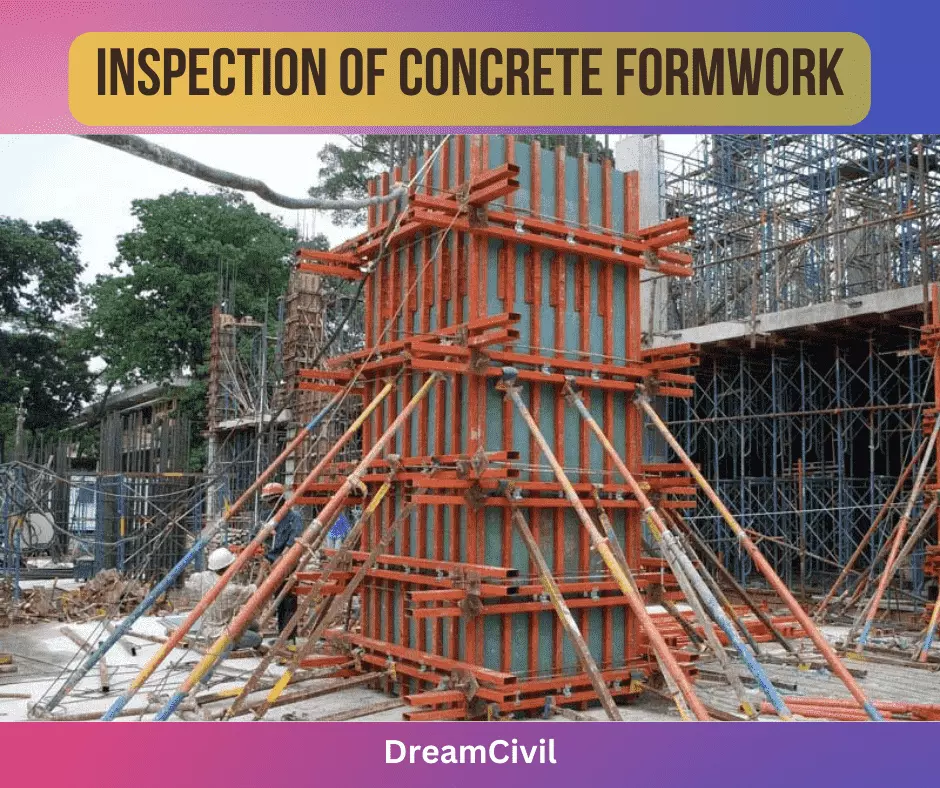Table of Contents
In this article, we will discuss the inspection of concrete formwork.
Formwork (also called falsework, centering, and shuttering) may be defined as the timber or other materials which are used to form molds into which concrete is poured at the site.
1. Inspection of Concrete Formwork
At the time of the pouring of concrete formwork, the following checks are done:
1. Any components that are to stay in position after the general dismantling is accomplished, should be clearly labeled.
2. Materials utilized should be reviewed such that no wrong items/rejects are utilized.
3.1f there are pits nearby corrective and strengthening protection should be supposed to impact the safety of formwork.
4. Bearing soil must be tough and well-designed and the sole plates shall attend well on the ground. Sole plates shall be suitably sealed on their hearing pads or sleepers. The hearing plates of the steel support shall not be damaged. The steel parts on the hearing members shall have sufficient hearing areas.
5. Safety actions are considered to control the result of traffic, scour clues to water, and accidental results.
6. To guarantee the strength and stability of formwork at the middle stage, bracing, struts, and ties shall be established along with the progress of work. Tilting and overturning of steel sections shall be neglected or restrained.
7. When adjustable creel props are utilized, damage and visible bents should be seen; steel pins should be delivered, and restrained latterly near each end.
8. Screw adjustments of adjustable props shall not be overextended
9. If settlement/elastic shortening of props occurs, double wedges shall be provided for adjustment of the farm to the required position. Wedges are utilized only at the bottom end of a single prop and should not be too steep and one of the pair should be tightened/clamped down after adjustment to prevent their shifting.
10. No members shall be eccentric over vertical members.
11. Adequate number of bolts and nuts and cantilever supports shall be provided
12. Props shall be directly under one another in multistage construction.
13. Guy ropes or stays shall be tensioned properly
14. Requirement shall be completed for the movement and operation of the vibrator and other plant and equipment
15 Required camber shall be provided over long spans.
16. Supports shall be adequate and in plumb.

Hope this post will help you in the inspection of concrete formwork on the field.
2. Requirements of Good Formwork
The following are the requirements of good formwork:
a. It should be adequately strong.
b. It should be stiff.
c. It should be smooth.
d. It should provide a good shape at the concrete face.
The following points about formwork are worth noting:
a. The joints made in the formwork should be simple. The joints of the formwork should be preferably tongued and grooved to ensure water-tightness and minimize the possibility of the slurry oozing out.
b. The surface of formwork that is to come in contact with concrete is usually coated with crude oil or soft soap solution, to prevent the possibility of concrete getting stuck to it.
c. All formwork must be so made that it can be easily stripped after concrete sets.
d. The formwork should be so designed and constructed that it can be struck in the desired order.
e. Every effort shall be made to minimize timber wastage during the construction of formwork since the cost of formwork may amount to about 20 percent of the cost of some of the jobs.
f. The formwork should be carefully inspected by the Engineer-in-chief and only after making sure that the formwork is properly made, the concreting process must be allowed.
g. The formwork, during concreting, should be continuously in observation for bulges and other signs of failure.
| Read Also: Grades of Cement Mortar |

